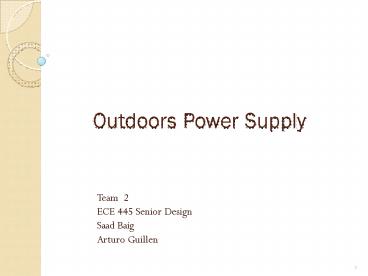Outdoors Power Supply - PowerPoint PPT Presentation
1 / 37
Title:
Outdoors Power Supply
Description:
Outdoors Power Supply. Team 2. ECE 445 Senior Design. Saad Baig. Arturo Guillen. 1. Table of Contents ... Under-voltage lockout at 1.65 V. Hiccup over-current ... – PowerPoint PPT presentation
Number of Views:43
Avg rating:3.0/5.0
Title: Outdoors Power Supply
1
Outdoors Power Supply
- Team 2
- ECE 445 Senior Design
- Saad Baig
- Arturo Guillen
2
Table of Contents
- Introduction
- Features
- Design Overview
- Testing
- Successes and Challenges
- Recommendations
- Potential Improvements
- Acknowledgments
- Questions
3
Introduction
- The outdoor power supply
- Purpose
- Implementation
- Two stages
- Power generation
- DC-DC conversion
4
Features
- Multiple outputs (12 V, 5V, Universal)
- Portable
- Runs on conventional fuel
- Ease of use
5
Design Overview
- Basic block diagram
6
Thermoelectric Generation
- What is a TEG?
- No moving parts
- Completely silent
- Highly reliable
7
Initial TEG Housing Structure
- Design parameters
- 200 psi Compressive Loading
- Uniform Load
- Insulation
8
Final Structure
- Fan
- Water pot heatsink
- Compression at the edges
- Insulation at the base
9
Initial Converter Design
- Comparison of different topologies
- Flyback and Boost have high efficiencies
10
IV Characteristic of HZ 14
11
Flyback Advantages
- Flyback Topology
- Dielectric isolation
- Minimal parts required
- Easily derive multiple outputs
12
Flyback Design Issues
- Low input voltage from TEG
- Very high peak currents on the primary
- Challenging inductor design
- Availability of materials
13
Final Converter Design
- Boost topology
- Main components
- Inductor
- MOSFET
- Diode
- Output Capacitor
14
Two-Stage Boost
15
Boost Schematic (PCB Design)
16
Controller
- TPS 43000
- Under-voltage lockout at 1.65 V
- Hiccup over-current protection
- Imax(hu) .25 / RDS(ON) 11.36 A
- Low power mode
17
Inductor Calculations
- Minimum inductance needed to avoid operating in
DCM - 5 V
- Lcrit 1.908 uH
- 12 V
- Lcrit 11.27 uH
Lcrit (Rmin / 2) Tsw (1-D)2D
18
Output Filter
- Moderate voltage ripple at the output
- 5 V
- C0 min 3.6 uF
- 12 V
- C0 min 16.8 uF
Cout min I0 max Dmax / ( fin vripple )
19
Feedback Network
- Vr Rbias/(RbiasR1) Vout
- Vout 1/(1-D) Vin
20
Testing TEG
- Approximate module ? T
- Verify power output
- Verify module integrity
- Calculate temperature differences across
interfaces
21
Approximate Module ?T
- Measured temperatures
- Th 2740 C
- Tc 1250 C
- Measured open circuit voltage
- Voc 1.93 V
?T 1100 C
22
Verify Power Output
P0 4.9 Watts
23
Verifying Module Integrity
- Voltage across .3? load
- VR 1.427 V
- Module current
- I VR / RL 4.76 A
- Internal resistance
- Ri ( VL-Voc )/ I .126 ?
24
Calculating ?Ti
- Interface temperature drop
- ?Ti (Th - Tc) ?T 390 C
- Values in the range of 300 C to 500 C are
acceptable
25
Testing Boost Converter
- Vds, Vgs, output voltages and ripple voltages
- Efficiencies at different loads
- Testing in conjunction with the TEG
- Line and load regulation
26
Converter Waveforms
5 V
12 V
Drain Voltage
Gate Voltage
27
5 V Converter Efficiency
?? 1 Ploss/Pin
28
12 V Converter Efficiency
29
5 V TEG/Supply Testing
30
12V TEG/Supply Testing
31
Line And Load Regulation
- 5 V
- Load reg 2.2 (.11 V)
- Line reg 1.2 (.06 V)
- 12 V
- Load reg 5.0 (.6 V)
- Line reg 2.2 (.264 V)
Line regulation Vout (highest input) Vout
(lowest input)/ Vout nominal
Load regulation Vout (no load) Vout (max
load)/ Vout nominal
32
Successes
- Both converters worked
- Good efficiencies on the converter
- TEG was able to provide sufficient power
33
Challenges
- Lead time on parts
- Low input voltage controllers uncommon
- Time constraints
- Magnetics design can be complex
34
Recommendation
- Importance of documentation
- Maintain a well organized lab journal
- Record ideas, implementation, test data, etc
- Explore multiple sources
- Verify design equations against different sources
- Utilize design tools provided by manufacturer
35
Potential Improvements
- Circuitry for low-power temperature controlled
heat sink fan - Better TEG structure
- Compression/Thermal expansion
- Uniform Load
- Smaller and lighter design
- Safety
36
Acknowledgments
- Professor Paul S. Carney
- Professor Patrick L. Chapman
- Professor Philip T. Krein
- Paul Rancuret
- ECE machine shop
- Scott McDonald
- David Switzer
- Greg Bennett
- ECE parts shop
- Mark Smart
- Power Lab
- Andy Friedl
- Kevin Colravy
- Ben Niemoeller
37
Q A
QUESTIONS ?
























![[2022-2032]: “Power Sports Batteries Market” by Qualitative Analysis | with Top Market Players PowerPoint PPT Presentation](https://s3.amazonaws.com/images.powershow.com/9906379.th0.jpg?_=20230712081)






